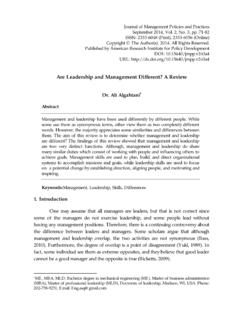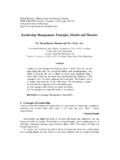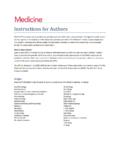Transcription of Extensions to Mendelian Genetics
1 1 Chapter 4!! Extensions toExtensions to Mendelian Mendelian GeneticsGenetics! Gene Interactions2 Gene Interactions Extensions to Mendelian Genetics Just as different alleles of 1 gene can interact in complexways, 2 different genes can also act together to modify aphenotype: 2 genes 1 phenotype (Additive Gene action )Complementation ( complementary gene action )Epistasis (recessive and dominant)Redundancy3 Multifactorial Inheritance Vast majority of traits are determined by multiple factors: genetic as well as environmental. Gene interactions between two or more genes Example: Lentil Seed color.
2 F1 all same, F2: 4 different phenotypes F2 phenotypic ratio is 9:3:3:1 (same as F2 dihybrids in Mendel s original crosses). Difference: in original crosses: 2 independent traits/phenotypes=2 independent genes; Seed color and seed shape here: multiple phenotypes of 1 trait=2 independent genes Seed color can tell thisgenotype is causedby more than onegene : because there are 4phenotypes not 3 inF2 1 gene F2 wouldhave 3 phenotypes1:2:1 ratio(Additive Gene action )5F2 phenotypes Dominance Relationships: Tan is dominant to green Gray is dominant to green Brown is dominant to gray, green and tan.
3 Tan and Gray are incompletely dominant, giving riseto brown. Genotypic classes: Brown: A_B_ Tan: A_bb Gray: aaB_ Green: aabb6 complementary Gene action Each genotypic class may not always dictate a unique phenotype A pair of genes can often work together to create a specificphenotype. We call this complementary interaction. With this type of interaction we see 2 different phenotypesinstead of the 4 seen in 2 genes 1 phenotype Two or more genotypic classes may display an identicalphenotype. Example: Two lines of pure breeding white flowered pea plantsfalling into different genotypic classes: AAbb & aaBBThe must have a dominantallele in both genes to result inthe purple flower phenotype789 Epistasis One gene s allele masks the phenotype of the othergene s alleles.
4 Four genotypic classes produce fewer than fourphenotypes. Different types of epistasis: Recessive epistasis: when the recessive allele ofone gene masks the effects of either allele of thesecond gene. Dominant epistasis: when the dominant allele ofone gene masks the effects of either allele of thesecond Epistasis Example 1: Coat color of Labrador retriever Example 2: ABO blood groups: Bombayphenotype. Phenotypic ratios are 9:3:4 in XPF1 Coat-Color Inheritance inLabrador Retrieversgoldenblackblack12 Recessive Epistasis:a recessive mutation in one gene masks the phenotypic effects of anotherF1XF29 : 3 : 4 Appears likeincomplete dominance becausesome of the progenylook like neither parent, but the ratiois black: 3 brown: 4 golden (9 B-E-: 3 bbE-: 3 B-ee.)
5 1 bbee)xF2BE Be bE beBEBebEbeAACCAACcAacCCAACcAAccAacCcAacc cAacCcacacCCacacCcacacccacacCcAacccAacCc AacCCAACcBbEeBbEeBBEEBBEeBbEEBbEeBBEeBbE EBbEeBbEeBbEeBBeeBbeebbEebbeebbEEBbeebbE eDihybrid Cross:14 Molecular ExplanationPigment production (B) and subsequent incorporation (E) intothe hair shaft are controlled by two separate genes. To be black,both genes must function. Mutations in B (b) lead to brownpigment. Mutations in E (e) lead to no pigment in B gene E34915 Recessive Epistasis Two genes involved in coat color determination. Gene B determines whether black (B) or brown (bb)pigment is produced.
6 Gene E determines if pigment is deposited in hair golden retrievers (ee) make either black (B-) or brown(bb) pigment (look at noses).. but not in fur The recessive allele is epistatic to (stands over) other geneswhen homozygous -- hence the name recessive epistasis Phenotypes do not segregate according to Mendelian ratios(the phenotypic ratios are modified Mendelian ratios). epistasis - (Greek, to stand upon or stop) the differentialphenotypic expression of a genotype at one locus causedby the genotype at another, non allelic, locus. A mutationthat exerts its expression by canceling the expression of thealleles of another Epistasis caused by the dominant allele of one gene,masking the action of either allele of theother gene.
7 Ratio is 12:3:1 instaed f 9:3:3:1 Example: Summer Squash1718 Petal color insnapdragons -if Mendel had usedsnap dragons forhis experiments,he wouldn t befamous!XF1F215/16 red; 1/16 whitePAABBA-B-aabbRedundancy: Duplicate Genes19AB Ab aB abABAbaBabAACCAACcAacCCAACcAAccAacCcAacc cAacCcacacCCacacCcacacccAacCCAACcAABBAAB bAAbbAABbAaBBAaBbaaBBAaBbAaBBAaBbAabbaaB bAaBbAabbaaBbaabbA-B-A-B-X15/16 A-B- red; 1/16 aabb whiteWhenever a dominant gene is present, the trait is expressed. One allele is sufficient to produce the for figuring out gene interactions:Look at the F2 phenotypic ratios!
8 ! If one gene is involved in the trait, then the monohybridphenotypic ratio is: 3:1 or 1:2:1 or 2:1 If two genes are involved in the trait, then the dihybridphenotypic ratio is: 9:3:3:1 or some permutation (9:4:3 or 9:7 or 12:3:1)"The 1/16 class is always the double homozygous recessive." Look for internal 3:1 ratios, which will indicate dominance/recessive relationships for alleles within a for figuring out gene interactions: 2 Genes 1 Phenotype (Additive Gene action ): You can tellthis genotype is caused by more than one gene because thereare 4 phenotypes not 3 in F2 (9:3:3:1) 1 gene F2 would have 3 phenotypes 1:2:1 ratio complementary Gene action : one good copy of each geneis needed for expression of the final phenotype 9:7 ratio Epistasis: one gene can mask the effect of another gene 9:3:4 ratio for recessive epistasis 12:3.
9 1 ratio for dominant epistasis Duplicate genes: only double mutant has mutant phenotype 15:1 ratio22variations on Mendelian inheritance Gene interactionInheritancepatternA-/B-A-/bba a/B-aabbratioAdditiveComplementaryRecess iveEpistasisDominantEpistasis99993333333 311119:79:3:412:3:19:3:3:1 Each genotype resultsin a unique phenotypeOne dominant allele fromeither of twogenes neededfor phenotypeHomozyous recessivegenotype at one locus masksexpression at second locusDominant allele at onelocus masks expressionat second locus933115:1 DuplicateGenesAt least one dominantallele from each of twogenes needed for phenotype23true breeding brown dogs X true breeding white dogsF1 = all whiteF2 = 118 white 32 black 10 brown# Find the genotypes of the dogs in each class:What is the ratio?
10 1231 How many genes?2 What is the ratio of white to colored dogs?12:4 = 3:1 This means that white is dominant to colored so let s callone gene: W= white w=coloredSample Problem24 What is the ratio of black to brown dogs?3 : 1So black must be dominant to brown. So we will call the second gene: B=black and b=brownWhat class of dogs are the double recessive homozygotesand what is their genotype?Brown - wwbbWhat is the genotype of the black dogs?Must be wwB-What are the genotypes of the white dogs?W_ B_ and W_bb# This is an example of dominant epistasis (white).F2 = 118 white 32 black 10 brown25 Same Genotype may producedifferent Phenotypes Penetrance: Genotype does not necessarily define proportion of individuals with a given genotype express thephenotype determines penetrance.
















